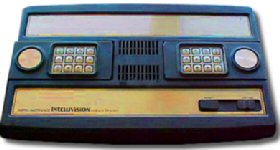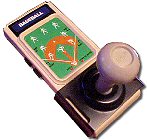 It was touted as “Intelligent Television,” a new peak in video game interaction, and hey, with those numeric keypads on the controllers, there was even a slight hint that there would be wholesome educational games on the way. Mattel’s Intellivision – released in 1980 to compete with the Atari 2600 and the Odyssey 2 – was supposed to be the next big thing.
It was touted as “Intelligent Television,” a new peak in video game interaction, and hey, with those numeric keypads on the controllers, there was even a slight hint that there would be wholesome educational games on the way. Mattel’s Intellivision – released in 1980 to compete with the Atari 2600 and the Odyssey 2 – was supposed to be the next big thing.
But Intellivision had numerous things working against it. By the time Mattel introduced its own game console, the Atari 2600 had established a foothold – and the ColecoVision and Atari 5200  were only a year or two away from being on the market. From whatever direction one looked, the Intellivision was in the wrong place at the wrong time. One of the system’s big attractions – Mattel’s promise to release a computer peripheral – was beset by numerous delays, and only after the company was subjected to Federal Trade Commission inquries did Mattel put the peripheral on the market. The eventual release of the computer peripheral only happened to prevent legal disaster: it fell far short of expectations and certainly didn’t transform the Intellivision into the promised home computer – but despite that, nearly every game
were only a year or two away from being on the market. From whatever direction one looked, the Intellivision was in the wrong place at the wrong time. One of the system’s big attractions – Mattel’s promise to release a computer peripheral – was beset by numerous delays, and only after the company was subjected to Federal Trade Commission inquries did Mattel put the peripheral on the market. The eventual release of the computer peripheral only happened to prevent legal disaster: it fell far short of expectations and certainly didn’t transform the Intellivision into the promised home computer – but despite that, nearly every game  manufacturer since the Intellivision’s time has announced a computer add-on, and like Mattel, few of them have delivered on the promise.
manufacturer since the Intellivision’s time has announced a computer add-on, and like Mattel, few of them have delivered on the promise.
Though they were seen as a nuisance at the time, Intellivision’s “disc pad” controllers were very early progenitors of the same style of controller that Nintendo made commonplace with its NES joypads almost a decade later. And even though Mattel and numerous third-party manufacturers made sure that the Intellivision library was well-stocked with popular arcade titles, the Intellivision’s fortè was over-complicated games like Advanced Dungeons & Dragons, Utopia, and Tron Maze-a-Tron. They went over great with enthusiasts of complicated board and role-playing games, but alienated players who had bought the Intellivision in the simple hope of finding more faithful renditions of arcade classics than could be found on the Atari 2600.
[jwcatpostlist orderby=title order=asc includecats=42,127]


 Intellivision extras: from left to right, an optional clamp-on joystick to make the clumsy joy-disc controllers more manageable, the abandoned General Instrument PlayCable peripheral (essentially an early cable modem that could be used to download games from a special cable channel, tested in only a few markets between 1981 and 1983), and the ill-fated Intellivision computer keyboard add-on.
Intellivision extras: from left to right, an optional clamp-on joystick to make the clumsy joy-disc controllers more manageable, the abandoned General Instrument PlayCable peripheral (essentially an early cable modem that could be used to download games from a special cable channel, tested in only a few markets between 1981 and 1983), and the ill-fated Intellivision computer keyboard add-on.
